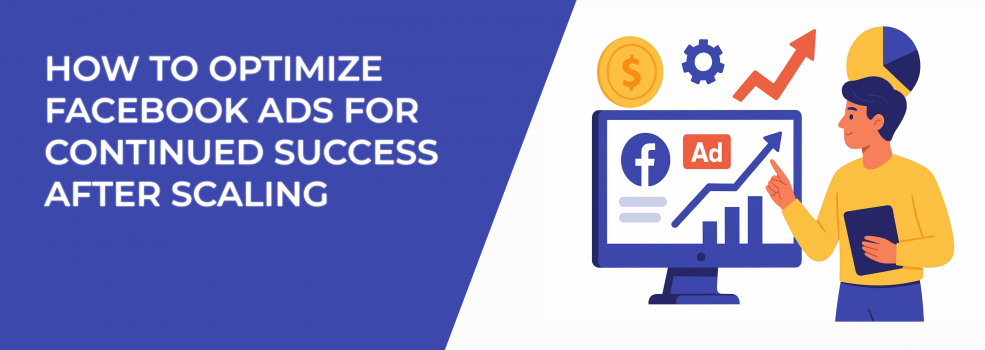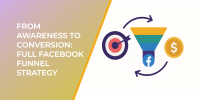So, you’ve scaled your Facebook ads. Your budget is up, your reach has grown, and things were looking pretty great for a while. But now, your results are slowing down. Maybe your cost per lead has jumped, or your return on ad spend isn’t what it used to be.
What gives?
Scaling is a big achievement, but it’s not the finish line. In fact, it’s often where the real challenge begins. Once you grow your campaigns, everything shifts. Your audiences react differently, creative fatigue kicks in faster, and the Facebook algorithm needs to work harder to stay efficient.
The good news? You can keep your ads successful after scaling. You just need to know how to adjust.
Let’s walk through exactly what to do next.
1. Watch your performance closely after scaling
When you increase your ad spend, Facebook starts showing your ads to more people. That can help you grow, but it can also lead to unpredictable results.
Here's what to check every few days after scaling:
-
Are your conversion rates holding steady?
-
Is your cost per click going up?
-
Has your ad frequency spiked?
If something looks off, don’t wait. Go in and make adjustments. Lower the budget slightly, test a new audience, or swap in fresh creative. The key is to respond before the dip gets worse.
Often, you can see that your ads perform really well right after scaling, but then performance starts dropping again.
Tip: create a simple tracking sheet and log your core metrics every 2 to 3 days after scaling. This helps you catch changes early. If you're in the early stages of growth, this article on how to scale Facebook ads without breaking your results is something to check out as well.
2. Rotate creatives before it gets stale
When you scale, your ads are shown more often. That means your audience gets tired of seeing the same images and messages.
Ad fatigue is real. And it kills performance.
To avoid it:
-
Add 2 or 3 new creatives every week.
-
Try different types of visuals — video, carousels, UGC-style clips, and product demos.
-
Change your headline and call to action to match different customer mindsets.
Even small changes, like using a different opening line or color scheme, can keep things feeling fresh.
Tip: use Facebook’s built-in “Ad Relevance Diagnostics” to see when your engagement or quality scores drop. That’s a clear sign your ads need a refresh. If you're not sure whether your audience is experiencing creative burnout, this guide on how to spot and fix Facebook ad fatigue can help you catch it before it drains your budget.
3. Check if your audience is still working
When you first scale, Facebook starts expanding your reach. That can mean new people — but not always the right ones.
You might find your old audiences aren’t converting as well anymore. Or maybe your lookalike audience got too broad and less targeted.
Try this:
-
Create segmented audiences based on specific actions (like add-to-cart or 75% video views).
-
Exclude users who already bought or converted.
-
Revisit high-performing audiences from past campaigns and test them again.
Tip: don’t just target interests or lookalikes. Test custom audiences from website visits, email lists, or social engagement too. These are usually warmer leads and can help balance performance.
4. Avoid spreading your budget too thin
One common mistake after scaling is running too many ad sets or campaigns at once. You end up dividing your budget into tiny chunks — and none of your ads get enough data to optimize properly.
Instead, simplify.
-
Combine similar ad sets when possible.
-
Focus your budget on the top 2 or 3 campaigns that are driving results.
-
Let Facebook optimize across a smaller group of ads with enough daily spend.
Tip: a good rule of thumb is to give each ad set at least $20 to $50 per day to let the algorithm work. Less than that, and performance becomes unstable.
Too many ad sets with low spend can also slow down optimization. Learn how to exit the learning phase faster by focusing your budget where it matters most.
5. Keep an eye on ad frequency
Frequency measures how often the same person sees your ad. When it goes too high, people get bored or annoyed. That usually leads to higher costs and lower conversions.
Check frequency weekly. If it’s over 3.5 and results are falling, it’s time to act.
Try this:
-
Launch new creatives immediately.
-
Expand to a different audience group.
-
Use exclusions to avoid showing the same ad to the same people.
Tip: If you’re seeing good performance but high frequency, try using a retargeting ad with a stronger offer to push people toward action.
6. Look at your data in new ways
After scaling, your ad data gets more complex. It’s not just about daily spend or ROAS anymore. You’ll need to look deeper.
Start reviewing:
-
Results by placement (Feed vs. Reels vs. Stories).
-
Device type (mobile vs. desktop).
-
Age and gender breakdown.
-
Conversion paths (where your buyers came from and what they clicked on).
Tip: use Facebook’s breakdown tool and compare trends weekly. Are mobile users converting better? Are people on Instagram spending more? These little insights help you adjust and improve quickly.
Not getting the conversions you expected after scaling? Check out these practical fixes for underperforming Facebook ads to spot where your funnel might be leaking.
7. Give Underperforming Ads a Short Break
If a campaign is struggling, don’t be afraid to pause it — temporarily.
Taking a short break (1 to 3 days) gives the algorithm time to reset. It also gives you space to adjust your strategy, tweak creatives, or refine targeting.
Just don’t pause everything at once. Choose specific ad sets that have dropped in performance, especially if frequency is high or ROAS is declining.
Tip: after the pause, relaunch with a slightly different setup — a new audience or a fresh creative. Often, performance will bounce back.
8. Stay flexible and keep testing
Scaling isn’t a one-time move. It’s a stage that requires ongoing effort.
The most successful advertisers don’t just grow. They keep learning, testing, and adjusting. They know that what worked last month might need to change this month.
So keep asking:
-
What’s working right now?
-
What can I test next?
-
How can I simplify without losing momentum?
Even small tweaks, like testing a new headline or targeting a different device, can have a big impact.
Tip: schedule a 30-minute check-in with your ad account every week. Look for trends, test one new thing, and optimize the rest.
Final thoughts
Scaling your Facebook ads is a big win. But keeping them profitable afterward? That takes strategy, attention, and consistent action.
Watch your data, rotate creatives regularly, simplify your campaigns, and never stop testing. When you stay curious and flexible, you’ll find ways to keep growing — without burning out your budget or your audience.

